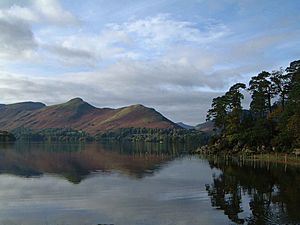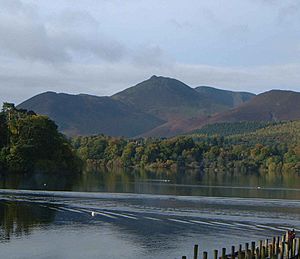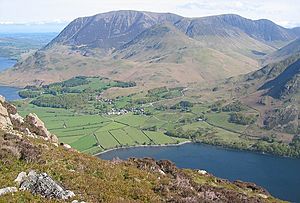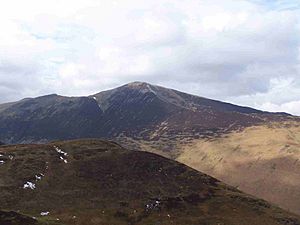North Western Fells facts for kids
The North Western Fells are a special group of hills in the English Lake District. They include popular spots like Catbells and Grisedale Pike. These fells form an oval shape, sitting below the beautiful Buttermere and Borrowdale valleys. The North Western Fells are known for their long ridges that run from east to west. They also don't have many mountain lakes, which are called tarns.
Contents
Exploring the Lake District Fells
The Lake District is a famous National Park in northwest England. It's not just full of amazing lakes, but also has many hills. These hills are called fells by local people. They can be small hills or some of the highest peaks in England.
Many people have tried to list all the fells. They often divide the area into smaller parts to make them easier to describe. The most famous person to do this was Alfred Wainwright. He wrote a series of books called Pictorial Guide to the Lakeland Fells. These books have been very popular since 1952.
Wainwright divided the fells into seven main areas. Each area is surrounded by valleys and low passes. Even though other writers have made their own maps, Wainwright's seven areas are still the most well-known. The North Western Fells are one of these areas. They are covered in Volume 6 of Wainwright's books.
Where Are the North Western Fells?
The North Western Fells are a clear, separate group of hills. Their edges are easy to see. The only place they connect to other high ground is at the top of Honister Pass in the very south. On the other side of this pass are Fleetwith Pike and the Western Fells.
The rivers that flow from Honister Pass go north. They run side-by-side for about 12 miles. To the west is the River Cocker. It flows through Buttermere and Crummock Water. The eastern edge is formed by the River Derwent system. This includes Derwent Water and Bassenthwaite Lake. The River Derwent eventually turns west and joins the Cocker near Cockermouth. This completes the circle around the fells.
What Do the North Western Fells Look Like?

It's unusual for high fell areas, but the North Western Fells have two roads that cross them. Both roads go from east to west. They connect the valleys on either side. Newlands Pass goes from Braithwaite village to Buttermere. Whinlatter Pass takes a more northern route from Braithwaite to High Lorton. These two passes split the North Western Fells into three main parts.
Southern Fells: Catbells and Beyond
The most southern part is a ridge that runs from northeast to southwest. It starts with the popular family climb of Catbells. The high ground then continues over Maiden Moor, High Spy, Dale Head, Hindscarth, and Robinson. Castle Crag, which is near High Spy, is also listed as a separate fell by Wainwright.
Central Fells: Grasmoor and Grisedale Pike
The middle area has two parallel ridges that run east to west. The southern ridge starts above Derwent Water with the bumpy shape of Causey Pike. It then goes west over Scar Crags, Sail, Eel Crag, Wandope, and finally Grasmoor. Grasmoor is the highest of the North Western Fells. It stands at 2,795 feet (852 meters) and drops steeply down to Crummock Water.
Some smaller fells to the south of this ridge are Ard Crags, Knott Rigg, Whiteless Pike, and Rannerdale Knotts. To the north are Barrow and Outerside. The parallel northern ridge includes Grisedale Pike. This fell looks like a sharp triangle from Keswick. It also includes Hopegill Head and Whiteside.
Northern Fells: Whinlatter and More
The fells to the north of Whinlatter Pass are generally lower and not as rugged. They include Whinlatter, Graystones, Broom Fell, Lord's Seat, Barf (which has a famous rock called 'Bishop'), Sale Fell, and Ling Fell.
Getting Around for Walkers

The North Western Fells are surrounded by roads. Plus, two more roads cross right through them. Towns like Keswick and Buttermere are good starting points in the north and west. You can also find parking at the tops of Honister, Newlands, and Whinlatter passes.
One of the most popular walks in this area is climbing Catbells from Hause End. You can even start this walk from Keswick by taking a boat across Derwentwater.



